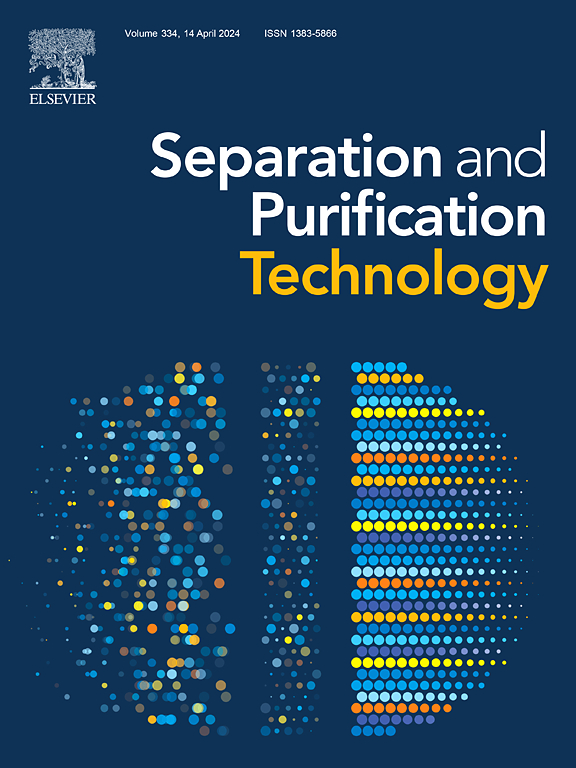Nickel in-situ doped cobalt-carbon composite loading on nickel foam to promote high-valent cobalt-oxo generation in peroxymonosulfate activation for ultra-fast organic oxidation and mechanism
IF 8.1
1区 工程技术
Q1 ENGINEERING, CHEMICAL
引用次数: 0
Abstract
The cobalt-carbon composite (C@Co) stands out as an ideal catalyst for generating high-valent cobalt-oxo (Co(IV)=O) species during peroxymonosulfate (PMS) activation, however, its application is badly constrained by the disadvantages of the inefficiency and unstable of Co(IV)=O generation, along with the challenge of recycling. To solve this limitation, in this work, Ni in-situ doped C@Co grown on nickel foam (C@CoNi/NF) was fabricated. The C@CoNi/NF-700 prepared at 700℃ had the highest PMS activation efficiency toward bisphenol A (BPA). Almost 100 % of BPA can be removed in 100 s with the first-order reaction constant (kobs) of 3.98 × 10-2 s−1. It was revealed that the Co(IV)=O played the pivotal role in BPA degradation with the contribution being 97.60 %. This led to the system exhibited high selective oxidation for organics, excellent anti-interference capabilities for co-existing ions in real water, wide pH adaptability and high stability. Theoretical calculation results showed that Co(IV)=O was generated with the cleavage of S-O and O-O bonds of PMS, which was totally different from the previous studies via the O-O and O–H bond cleavage. Additionally, the doped Ni0 can lower the reaction energy barrier of Co(IV)=O generation of C@Co. Finally, the continuous-flow experiment revealed the C@CoNi/NF-700 + PMS system exhibited a long-term stability and has a promising potential in practical purifying wastewater. This work not only developed one stable and easily recovery catalyst for rapidly selectively removing organics in wastewater, but also provided new insights into the Co(IV)=O generation pathway in PMS based AOPs.

镍原位掺杂钴碳复合材料负载泡沫镍促进高价钴氧在过氧单硫酸盐活化中超快速有机氧化及其机理
钴碳复合材料(C@Co)是在过氧单硫酸盐(PMS)活化过程中生成高价钴氧(Co(IV)=O)的理想催化剂,但Co(IV)=O生成效率低、不稳定以及回收困难等缺点严重制约了其应用。为了解决这一限制,本工作制备了生长在泡沫镍(C@CoNi/NF)上的Ni原位掺杂C@Co。在700℃下制备的C@CoNi/NF-700对双酚A (BPA)的PMS活化效率最高。当一级反应常数(kobs)为3.98 × 10-2 s−1时,在100 s内可脱除近100 %的BPA。结果表明,Co(IV)=O在BPA降解过程中起关键作用,贡献率为97.60 %。这使得该体系对有机物具有高选择性氧化,对实际水中共存离子具有良好的抗干扰能力,具有广泛的pH适应性和高稳定性。理论计算结果表明,Co(IV)=O是由PMS的S-O和O-O键断裂产生的,这与以往通过O-O和O- h键断裂产生的研究完全不同。此外,掺杂Ni0可以降低Co(IV)=O生成C@Co的反应能垒。最后,连续流实验表明,C@CoNi/NF-700 + PMS系统具有长期稳定性,在实际废水净化中具有广阔的应用前景。本研究不仅开发了一种稳定且易于回收的催化剂,可快速选择性去除废水中的有机物,而且为PMS基AOPs中Co(IV)=O生成途径提供了新的见解。
本文章由计算机程序翻译,如有差异,请以英文原文为准。
求助全文
约1分钟内获得全文
求助全文
来源期刊

Separation and Purification Technology
工程技术-工程:化工
CiteScore
14.00
自引率
12.80%
发文量
2347
审稿时长
43 days
期刊介绍:
Separation and Purification Technology is a premier journal committed to sharing innovative methods for separation and purification in chemical and environmental engineering, encompassing both homogeneous solutions and heterogeneous mixtures. Our scope includes the separation and/or purification of liquids, vapors, and gases, as well as carbon capture and separation techniques. However, it's important to note that methods solely intended for analytical purposes are not within the scope of the journal. Additionally, disciplines such as soil science, polymer science, and metallurgy fall outside the purview of Separation and Purification Technology. Join us in advancing the field of separation and purification methods for sustainable solutions in chemical and environmental engineering.
 求助内容:
求助内容: 应助结果提醒方式:
应助结果提醒方式:


